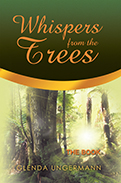
 |
Trees have messages for humanity. The author’s relationship with trees began when she had the realization that she is “part of the fairy realm known as elementals.” She touched a tree and felt its vibration; gradually, words emanated from within. As she communicated more, trees began to contact her internally, each using its individual name. Highgrove, in Tasmania, speaks of karma and the interconnectedness of all life. McGraw reminds us that trees “clean and prepare the air” and questions why they should be destroyed to make products like bark chips. Jannofay recalls the devastating pain of cyclones; Salamanda observes the destruction of widespread logging. Some trees cite lessons learned from past lives as humans. Some find their human admirers puzzling, and all wish us well. Their communications focus on peace, love, harmony, and the gift of wisdom.
Australian Ungermann transmits tree communications from many parts of the planet. She has arranged her book neatly; each segment is a tree’s declaration, titled with its “family” (not biological or common) name. She provides an index followed by about fifty black and white photographs that remind us that trees are unique and majestic. Her sincerity in collecting these spirit-borne messages is unquestionable, and the tone of her collection is positive, with the writing at times bordering on poetry. Some sections include her specific questions and the plant’s answers. Some are simple discourses, and others end with a particular message, often a blessing, from the tree to its human audience. Ungermann states that the trees have named her work simply “The Book” and consider it to be a valuable storehouse of their memories. Those with a strong awareness of connection to the natural world may appreciate this affirmative reminder that we share space on the earth with other sentient, sensitive creatures.